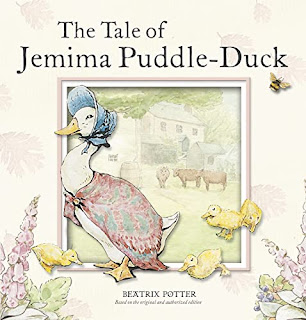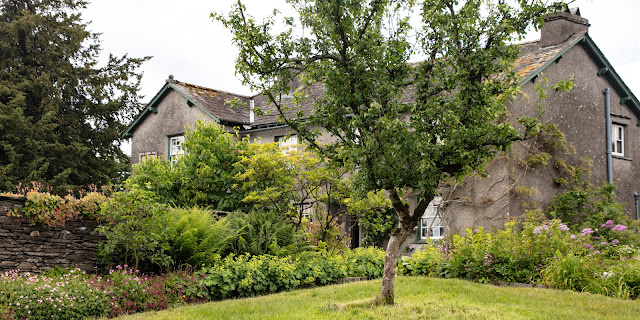Our next stop was a region in northern England that is often sited as the UK’s most beautiful area, the Lake District.
Also known as The Lakes or Lakeland, it is a mountainous region and National Park in Cumbria famous for its landscape and its literary associations with Beatrix Potter, John Ruskin and the “Lake Poets.”
 |
| A beautiful place |
The Cumbrian mountains, or fells, include England's highest: Scafell Pike at 3,209 feet, Helvellyn at 3,120 feet and Skiddaw at 3,054 feet (all about 3,000 lower than my house!). Plus, The Lakes has 21 major lakes. Lake Windermere is the largest and longest at 11 miles and Wast Water is the deepest at 259 feet.
The Lake District National Park was established in 1951 and covers an area of 912 square miles (slightly larger than Great Smoky Mountains National Park), comprising the bulk of the region. More than 18 million tourists visit per year (almost 40 percent more than the Smokies get).
 |
| The Lakes; Map: Wordsworth Country |
Unlike in the U.S., most of the land within the Park is privately owned, with about 55 percent agricultural. The National Trust owns around 25 percent of the total area.
 |
| We got one! |
We tried several times later in the trip and never got another stamp.
The Lake District's geology features a granite base that can be seen at the surface of some of the peaks.
Location coupled with its mountainous geography makes the Lake District the wettest part of England, with average annual precipitation of more than 80 inches. The mean temperature in the valleys ranges from about 37°F in January to around 59°F in July. Our time there was mainly overcast with a little rain.
Sheep farming has been the major industry since Roman times and is the source of the many stone walls in the area. The most common Sheep breeds are Herdwick, Rough Fell and Swaledale.
The area was badly affected by an outbreak of foot-and-mouth disease in 2001 and thousands of Sheep, including the native Herdwicks that graze on the fellsides across the District, were destroyed. Many of the lost Sheep were “heafed,” meaning that they instinctively did not stray from their specific areas. With all the Sheep lost at once, this location knowledge passed between generations had to be retaught. Some of the fells had discreet electric fences strung across them for a period of five years to allow the Sheep to "re-heaf."
With its wealth of rock types and their abundance in the landscape, mining and quarrying have long been significant activities in the Lake District economy.
.png) |
| Langsdale Axe; Photo: The British Museum |
Copper, lead, silver, baryte, graphite and slate mining was historically a major Lakes industry, particularly in the 16th to 19th centuries. There is still some mining today, but abandoned mines can be found throughout the District. Locally mined graphite led to the development of the pencil industry, especially around Keswick.
And, of course, walls and paths and barns and homes are all made of stone, some exposed and some plastered over.
 |
| Built of the land |
The Lake District is intimately associated with English literature of the 18th and 19th centuries. A group was called the "Lake Poets," which was originally a derogatory term created by the Edinburgh Review.
Just a few of the authors who wrote about the area or lived there are: Jane Austen, Thomas Carlyle, Samuel Taylor Coleridge and his son Hartley, Thomas De Quincey, Nathaniel Hawthorne, Ernest Hemingway, John Keats, Beatrix Potter, Arthur Ransome, John Ruskin, Sir Walter Scott, Percy Bysshe Shelley, Robert Southey, Lord Alfred Tennyson, Sir Hugh Walpole and, perhaps the district's most revered, William Wordsworth.
The Lakes have been an inspiration for many artists including Alfred Heaton Cooper, William Heaton Cooper, Laure Provoust, Canon Rawnsley, Kurt Schwitters, film director Ken Russell and composer Sir Arthur Somervell. Taylor Swift's Folklore song, The Lakes, details her her thoughts about the romantic site.
 |
| Swift sang The Lakes at the show we saw in Cardiff; Photo: Caty Stevens |
William Wordsworth published his Guide to the Lakes in 1810 and, by 1835, it had reached its fifth edition, now called A Guide Through the District of the Lakes in the North of England (looks like reverse editing). That book was particularly influential in popularizing the region.
 |
| Wild roses |
Wherever you look, there are colorful flowers, including lots and lots of roses.
The Lakes are filled with formal gardens and parks, many open to the public (some free and some for a fee).
Railways, built with industry in mind, brought a huge increase in the number of visitors. Then, tourism grew more as automobiles proliferated and railways were closed. The formation of The Lake District National Park recognized the need to protect the environment from excessive commercial or industrial exploitation, preserving that which visitors come to see. The M6 Motorway helped bring traffic to the Lake District.
Levens Hall
We started our Lake District adventures with a visit to Levens Hall, a stately manor house in the Kent Valley famous for its gardens and topiary.
The beautiful site has been settled since 1350 when the Redman family built a small pele tower (a fortified square keep commonly built for border protection).
 |
| A more current tower |
Much of the present house dates from the Elizabethan era, when the Bellingham family extended the building, adding paneling and plasterwork in the main rooms.
In 1689, they sold the estate to Col. James Grahme, or Graham, Keeper of the Privy Purse to King James II, who made a number of additions to the house. Further additions were made in the early 19th century.
Levens is now owned by the Bagot family and is open to the public.
The celebrated grounds and topiary garden were created between 1689 and 1712 by the French gardener Guillaume Beaumont, the gardener of King James II.
 |
| Topiary |
The gardens are very cool ...
 |
| ... with some interesting shapes … |
 |
| … beautiful flowers … |
 |
| … hedges … |
 |
| … bowers … |
 |
| … lots of bees (these are an Early Bumblebee and a Tawny Mining Bee) … |
 |
| … and a smattering of birds (this is a Eurasian Blackbird) |
The grounds also include ...
We toured the house, but no photography is allowed because it is a private home.
So, most of what we have to show for our visit, is photos of the lovely gardens.
Like so many places in the Lake District, Levens Hall opens rather late (10 a.m.), making it tricky to have a productive tourism day. We had to take a deep breath and practice tourism the English way – leisurely strolls.
We ate lunch there are a lovely café. I had a roasted beet salad and Caty had an asparagus salad.
Because driving and parking is generally difficult (not so at Levens, which has a carpark), we tried to eat meals onsite whenever possible.
Beatrix Potter House
 |
| Potter at Hill Top; Photo: The Writing Desk |
We missed our turn and had to double back and, then, the evil GPS gave us a new route. This was my first experience with narrow UK roads on the trip. And, were they ever narrow! And winding. And flanked by very close stone walls.
It was terrifying.
So terrifying that I had a hard time calming down to tour the house.
During the early 20th century, Potter set many of her famous Peter Rabbit books in the Lake District. Built in the 17th-century, Hill Top is an example of “Lakeland vernacular architecture” with random stone walls and a slate roof.
 |
| Hill Top |
 |
| The house is in the illustration |
The Hill Top house remains much as it was when Potter lived there, including housing many pieces of her furniture, some of which appear in her illustrations.
 |
| The garden is maintained in keeping with Potter's illustrations |
She dedicated The Tale of Jemima Puddle-Duck to his children, Ralph and Betsy, who appear in the illustrations, as does their mother.
The house contains three rooms downstairs: the entrance hall, parlor and scullery.
There are four rooms upstairs: the sitting room, treasure room, bedroom and new room. There are additional rooms not on the visitor route, including a cellar, a landing cupboard and a washroom, which did not contain plumbing, but was simply a space to wash using a bowl of water.
 |
| At the fireplace |
The staircase and landing appear in several of Potter's books and the carpets were woven to match those in The Tale of Samuel Whiskers.
The library, also called the “new room” because Potter added it in 1906, contains five large paintings by her brother, Walter Bertram Potter. The single window looks out over the village, a scene Beatrix drew for The Tale of Samuel Whiskers.
The only bedroom in the house contains an ornate four-poster bed dating from the mid-1600s. Potter's husband, William Heelis, carved their initials in the fireplace surround.
The Tale of Tom Kitten features the Hill Top garden. There is a vegetable garden, but Mr. McGregor's vegetables in The Tale of Peter Rabbit were painted at a garden called Lingholm before Potter acquired Hill Top.
 |
| The vegetable garden, right, had just been planted |
The "attraction" is fairly simple and sweet: just the house and gardens, plus some signage and posted illustrations.
There is a small store and coffee hut, plus lots of benches for sitting and contemplating the beautiful countryside.
Hill Top is a frequent destination of Japanese visitors to the UK. In 2007 a replica of the home was built in a children's zoo in Tokyo.
It was a lovely, gentle place to visit, but I am still not sure it was worth the harrowing drive.
Oh, and the route GPS gave us to leave was so much easier to drive than the insanely narrow road in that I think that trip in must have been a cruel joke.
Fern Howe Guest House
We then traveled on to Keswick, passing through some of the busiest towns, including Windemere, that I barely noticed. We stayed at the Fern Howe Guest House in Keswick in the village of Braithwaite between Derwentwater and Bassenthwaite Lake and close to Whinlatter Forest.
Getting there was fun, a sharp turn up a very steep narrow road to a (blissfully large enough) parking area in front of the house. Our pleasant room was on the top floor, up a narrow staircase that required us to crouch up the final course.
.jpg) |
| We were in the Wast Water (named after a lake) room; Photo: Booking.com |
We had a lovely dinner at The Royal Oak one night.
Once again, for a pub, it was remarkably upscale. I expected rowdy rooms with locals slugging down pints, but most of the pubs we visited were well-appointed with table service and inventive local cuisine.
I had planned out lots of places to explore, but, by now, we had already realized that touring by car was not as easy as we had thought. So, we scaled back a little.
I'll talk about what we did next time.
Trip date: June 6 - 20, 2024































No comments:
Post a Comment